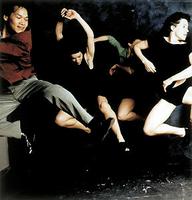
Dancemakers
Dancemakers is a Toronto-based troupe of about 10 dancers that was launched in April 1974. It was originally planned to be a one-time venture, run co-operatively among the participants but under the leadership of 2 graduates of the dance department at York University, Marcy Radler and Andréa Ciel Smith. At the time, the Toronto Dance Theatre and the National Ballet of Canada were the only professional dance companies in Toronto performing for adult audiences. Dancemakers sought to provide an alternative and to give a creative platform to a remarkable burgeoning of local dance talent.
The company, then mostly made up of York graduates, gave its first performance at the Bathurst Street Theatre in Toronto on 17 September 1974, performing a varied repertoire of Modern Dance works - a formula that lasted 14 years. Dancemakers became noted as a largely middle-of-the road modern-dance troupe favouring an eclectic mix of clearly structured and broadly accessible works. It presented work by such Canadian choreographers as Grant Strate, Anna Blewchamp, Jennifer Mascall, James Kudelka, Carol Anderson, Karen Jamieson, Judith Marcuse, Paula Ravitz and Conrad Alexandrowicz as well as by the British choreographer Norman Morrice and Americans Paul Taylor, Doris Humphrey, Lar Lubovitch and Robert Cohan.
For the first 3 years Dancemakers continued to function as a co-operative, but by 1977 Peggy Baker and Patricia Miner had been named co-directors. Anna Blewchamp took over briefly as artistic director in 1979, but resigned before presenting her first season and was succeeded by Baker. In the fall of 1980 founding company member Carol Anderson and dancer Patricia Fraser took over from Baker as co-artistic directors. Anderson became sole artistic director in 1985.
Anderson resigned in 1988 when it was clear that Dancemakers' original mandate to be a mainstream modern-dance repertory company needed rethinking. For many years it had helped its local audiences acquaint themselves with a remarkably varied spectrum of movement styles. However, the appearance of other local companies and the increased audience opportunities to see touring troupes from Canada and abroad meant that Dancemakers had to adjust and refocus, a point Anderson made to the company's board when she resigned. The board responded by appointing former dancer and innovative choreographer Bill James, with the understanding that the troupe would be a vehicle for the work of the artistic director. This concept was retained under Serge Bennathan, who succeeded James in 1990. The success of Bennathan's work gave Dancemakers a new identity and launched the company into a period of sustained artistic growth. Under Bennathan the company won wide critical acclaim for the quality of its dancing and distinctiveness of its repertoire. As with many contemporary dance troupes, Dancemakers does not maintain a constant repertoire but moves from project to project. Bennathan placed great emphasis on sharing and revealing the creative process with audiences in studio workshops preceding the official premiere of a new work. In 2002, Bennathan moved the company into its new home in Toronto's Distillery District and called it the Centre for Creation. The new space includes a theatre, which made Dancemakers a contemporary dance presenter as well as a performing company.
In 2006 Bennathan stepped down and Michael Trent became Dancemakers' artistic director and resident choreographer. Trent has continued to make collaboration and creative experimentation a cornerstone of Dancemakers' work.

 Share on Facebook
Share on Facebook Share on X
Share on X Share by Email
Share by Email Share on Google Classroom
Share on Google Classroom


